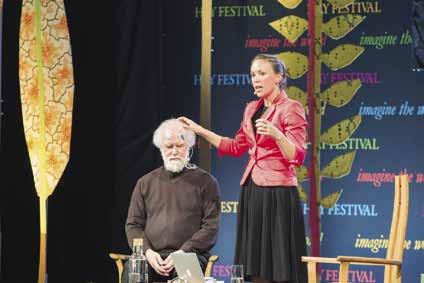
2 minute read
VII Gardens
What a difference a year makes. Spring 2017 was the driest for decades but spring 2018 the wettest. As I sit writing this article in late June it is some five weeks since we have seen a drop of rain in Cambridge. The garden team have almost gone insane with the seemingly endless deployment of hoses throughout College, endeavouring to keep alive borders and trees planted in the last couple of seasons, as well as several thousand bedding plants!
The garden team at work in First Court in Oct 2017 (photo: Matt Moon)
Advertisement
As ever, nature rolls her dice and the trees and plants respond. The tulips in First Court put on a wonderful display rising above the wallflowers, due to the high rainfall, as did the daffodils and fritillaries in the Fellows’ Garden. The saturated ground and lack of spring warmth delayed many of the early flowering shrubs and trees, but they were nevertheless floriferous as ever. As the heat of May and June parched the lawns and turned them into something akin to a field of hay, the Wisterias throughout College did something I have never seen before; a magnificent second flush of flower. The damp spring, in tandem with judicious feeding and spraying, ensured the roses throughout College put on their best display I have seen in my six years at Magdalene.

‘Albertine’ (photo: Matt Moon)
The Rosa x wichuraiana ‘Albertine’ smothered the end wall of Benson G with its gorgeous pink blooms in May and we are hoping for a good second flush in September.
The summer bedding scheme this year is pink Pelargoniums and Cosmos mixed with a variety of blues – Isotoma axilliaris ‘Gemini Blue’, Ageratum ‘Blue Champion’ and a new cultivar of Salvia called ‘Mystic Spires’ and a smattering of Verbena bonarensis. The Salvia has proved a big hit with the bees.
In the Scholar’s Garden, we have added to our collection of ornamental Japanese Cherries. A handsome specimen of Prunus x yedoensis, has been planted on the bank above the lawn behind the cottages on Chesterton Lane. The origin of this cherry is doubtful and it may be a hybrid between P.speciosa and P.subhirtella. It is planted abundantly in Tokyo and Yokohama, where it is known as the Yoshino Cherry. Ernest ‘Chinese’ Wilson (the plant biologist, E H Wilson, 1876–1930) describes it as ‘remarkably distinct from all other Japanese or Chinese cherries and one of the most floriferous and beautiful of them’. The flowers, pale pink fading to white and delicately scented are born in late March and April before the tree is fully in leaf. This should mature into a fine tree and give much beauty from the other side of the river as well as within College. We hope to carry on rejuvenating the Scholar’s Garden over the next couple of years and to increase the number of edible crops we grow in this part of College.
The new compost area, adjacent to the Scholar’s Garden, completed last summer has already produced some good quality organic matter. Much of late winter was spent spreading this across many of the borders and roses in College. Mark Scott

Rosa sp. in Mallory Court (photo: Matt Moon)










